Last updated on July 5th, 2025 at 03:28 pm
This Americana Star Table Runner Quilt Pattern uses red, blue, white, cream, and yellow fabrics. This rectangle tablecloth is perfect for patriotic holidays like Memorial Day or the Fourth of July, but it’s also a great accent piece any time of year.
This beginner table runner quilt pattern is broken into manageable steps that even a beginner can accomplish.
Make this quilt project using star flower blocks, pinwheels, and framed pinwheels. Use half square triangles, squares, and rectangle fabric pieces to create this beauty.
Quilt of Valor Table Runner Pattern
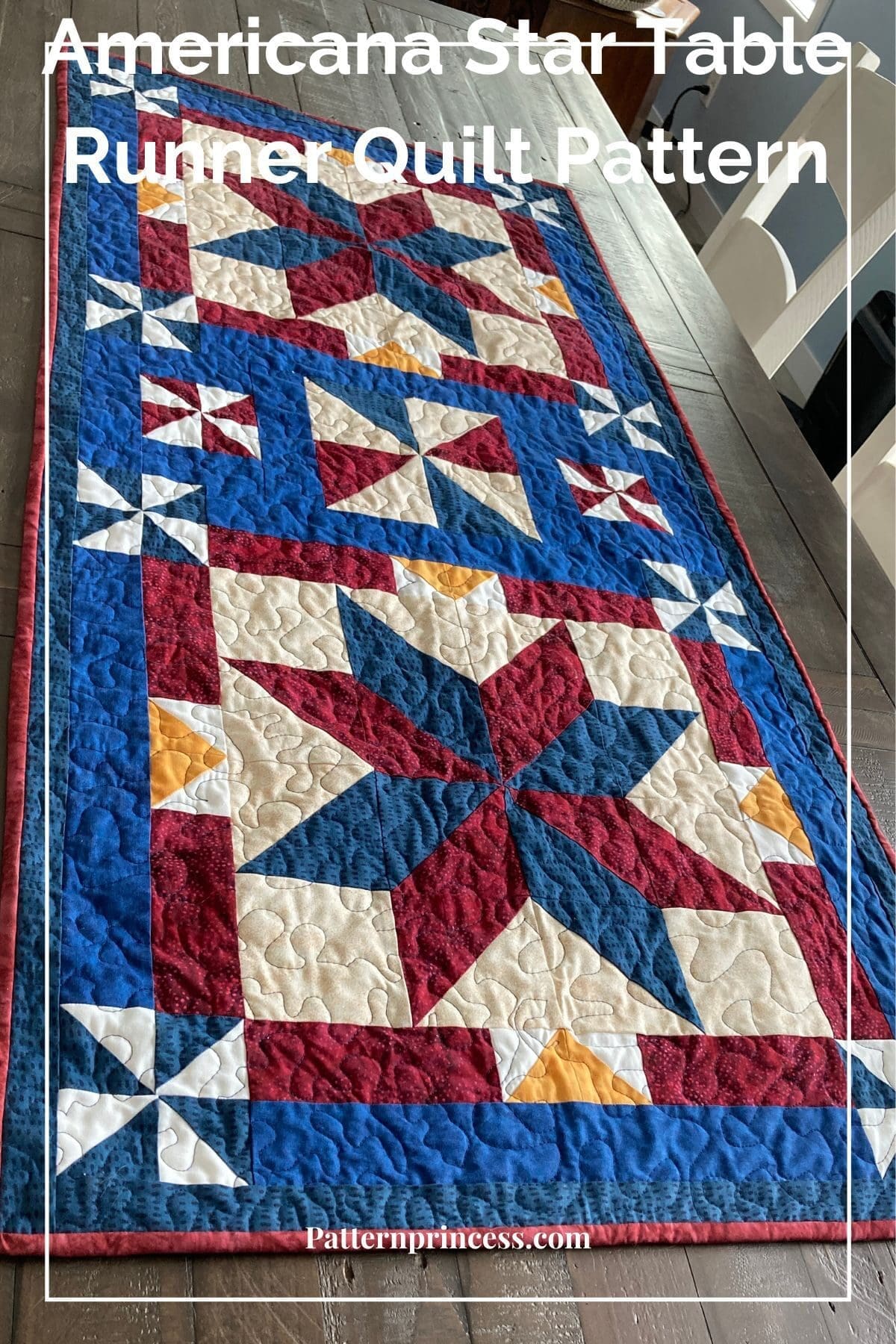
There’s something special about the Americana spirit that just can’t be denied. From artwork to fashion trends, including quilting of course, this sentiment is alive and well everywhere you look.
Celebrate your patriotic pride by crafting a beautiful quilt that is sure to bring some classic style into any home. The Americana Star Table Runner Quilt Pattern provides quilters with a great opportunity to create something unique while embracing traditional American charm.
This simple design will show off your red, white, and blue colors in graceful style while giving your home an homage to old-fashioned elegance. With just a few basic supplies and some dedication to the craftsmanship involved in quilting, you too can bring this timeless beauty into your home.
Whether it’s used as decoration or as a functional piece on your dinner table every night, this gorgeous heirloom will surely be admired by family members and guests alike.
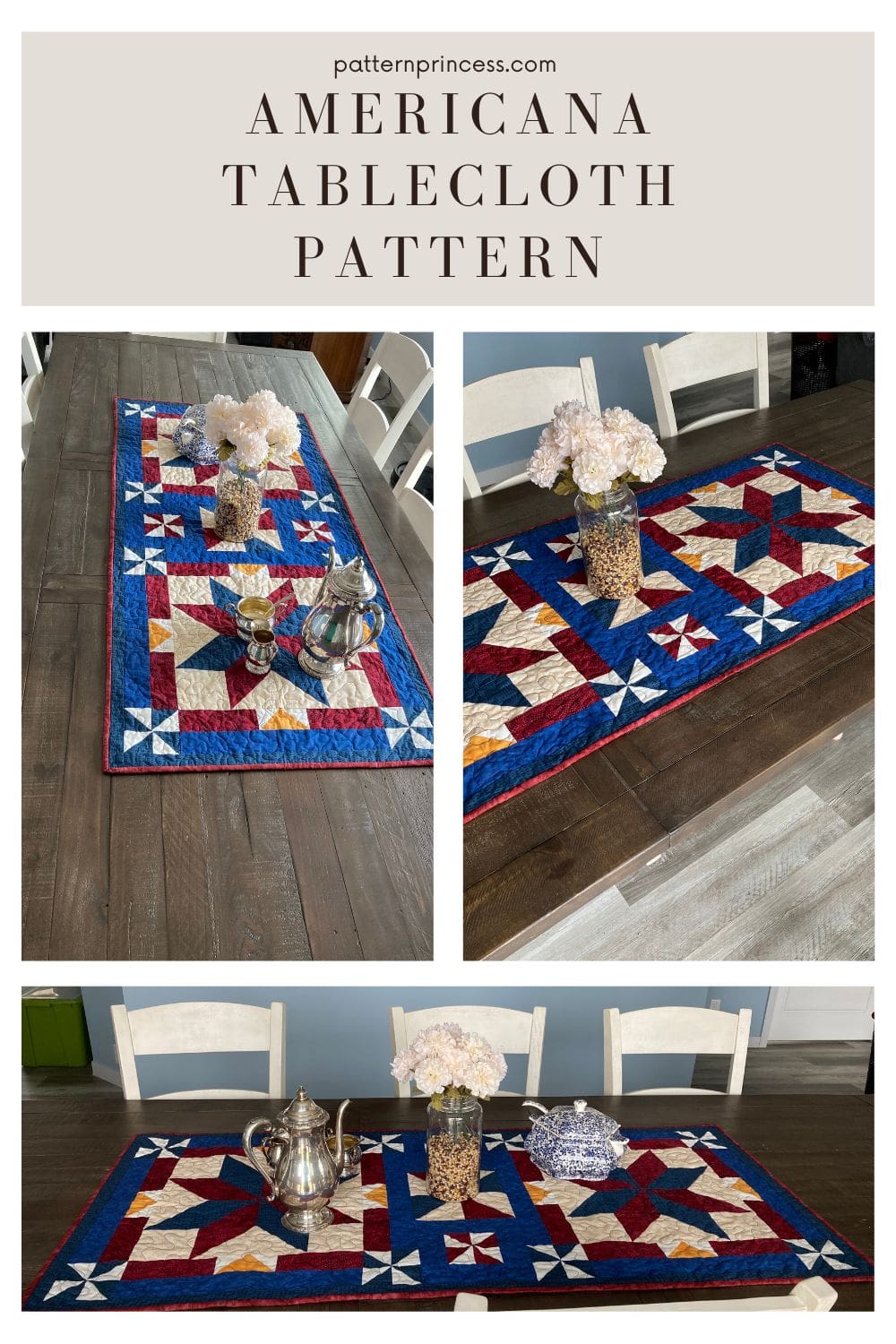
Directions: Americana Star Table Runner Quilt Pattern
Quilting Skill Level
Easy – Confident Beginner
Finished Size
The finished table runner measures 27” X 59”.
General Sewing Directions
The directions for this Americana Star Table Runner Quilt Pattern are for rotary cutting, machine piecing, machine quilting, machine sewing the binding to the quilt top, and hand-sewing the binding to the backing fabric.
Pin pieces before sewing them together to help align seams.
Accurately measure and cut fabric pieces as it will enhance the finished table runner.
All seams are sewn with 1/4 inch seam allowance.
Seams can be pressed open. However, if you prefer to press seams to one side or the other, I will have those suggestions within the instructions.
The finished table runner measures 27” X 59”.
The beginning measurements for the half square triangles are a bit larger than the finished block size needed. I like to make them a bit larger because the end result is a crisp and clean edge. This helps align all the seams and points better.
Fabric Preparation. I suggest using a cutting mat, quilting ruler, and a rotary cutter to prepare the fabric pieces.
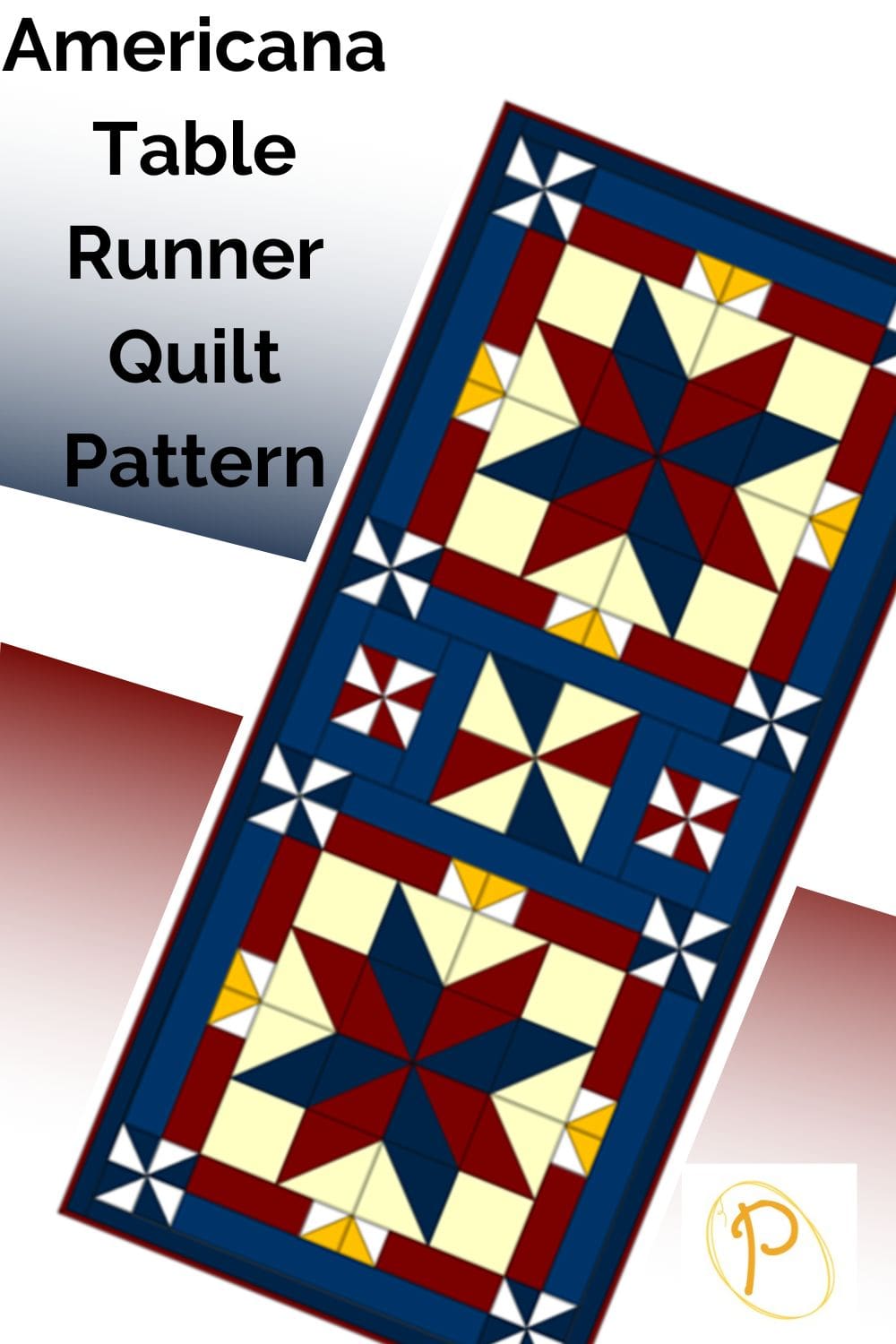
Fabric Requirements.
I suggest using 100% cotton quality fabric. For some of the sizes, you could get a fat quarter and have some fabric leftover for your next quilt project.
- Dark Blue colored fabric 2 yards
- Dark Red colored fabric 3/4 yard
- White colored fabric 1/2 yard
- Royal Blue colored fabric 3/4 yard
- Gold colored fabric 1/8 yard
- Cream colored fabric 1/2 yard
**It is assumed that the longer Dark Blue border piece will be cut first due to the length or it could be pieced together.
Backing fabric 2 yards. One single piece measuring 31” X 64”.
Batting. A piece measuring 31” X 64”, the same size as the quilt back. This will allow the batting to also extend beyond the edges of the table runner top.
Thread. I suggest a good quality quilting thread for sewing the table runner quilt top and quilting the pieces together. For hand sewing the binding onto the fabric backing, get a good hand quilters thread.
Cut the following pieces of fabric.
Dark Blue Fabric
- Cut 16 – 3 7/8” X 3 7/8” squares.
- Cut 8 – 5 7/8” X 5 7/8” squares.
- Cut 1 – 5 7/8” X 5 7/8” square.
White Fabric
- Cut 16 – 3 7/8” X 3 7/8” squares.
- Cut 8 – 3 7/8” X 3 7/8” squares.
- Cut 4 – 3 7/8” X 3 7/8” squares.
Gold Fabric
- Cut 8 – 3 7/8” X 3 7/8” squares.
Royal Blue Fabric
- Cut 8 – 2 1/2″ X 16 1/2″ rectangles.
- Cut 4 – 2 1/2″ X 4 1/2″ rectangles.
- Cut 4 – 2 1/2″ X 8 1/2″ rectangles.
Red Fabric
- Cut 16 – 2 1/2″ X 6 1/2″ rectangles.
- Cut 8 – 5 7/8” X 5 7/8” squares.
- Cut 1 – 5 7/8” X 5 7/8” square.
- Cut 4 – 3 7/8” X 3 7/8” squares.
Cream Fabric
- Cut 8 – 5 7/8” X 5 7/8” squares.
- Cut 8 – 4 1/2″ X 4 1/2″ squares.
- Cut 2 – 5 7/8” X 5 7/8” squares.
Let’s Begin the Star Table Runner Quilt
Dark Blue and White Pinwheel Block

Use the following fabric:
- Dark Blue Fabric Cut 16 – 3 7/8” X 3 7/8” squares.
- White Fabric Cut 16 – 3 7/8” X 3 7/8” squares.
Sew the Pinwheel
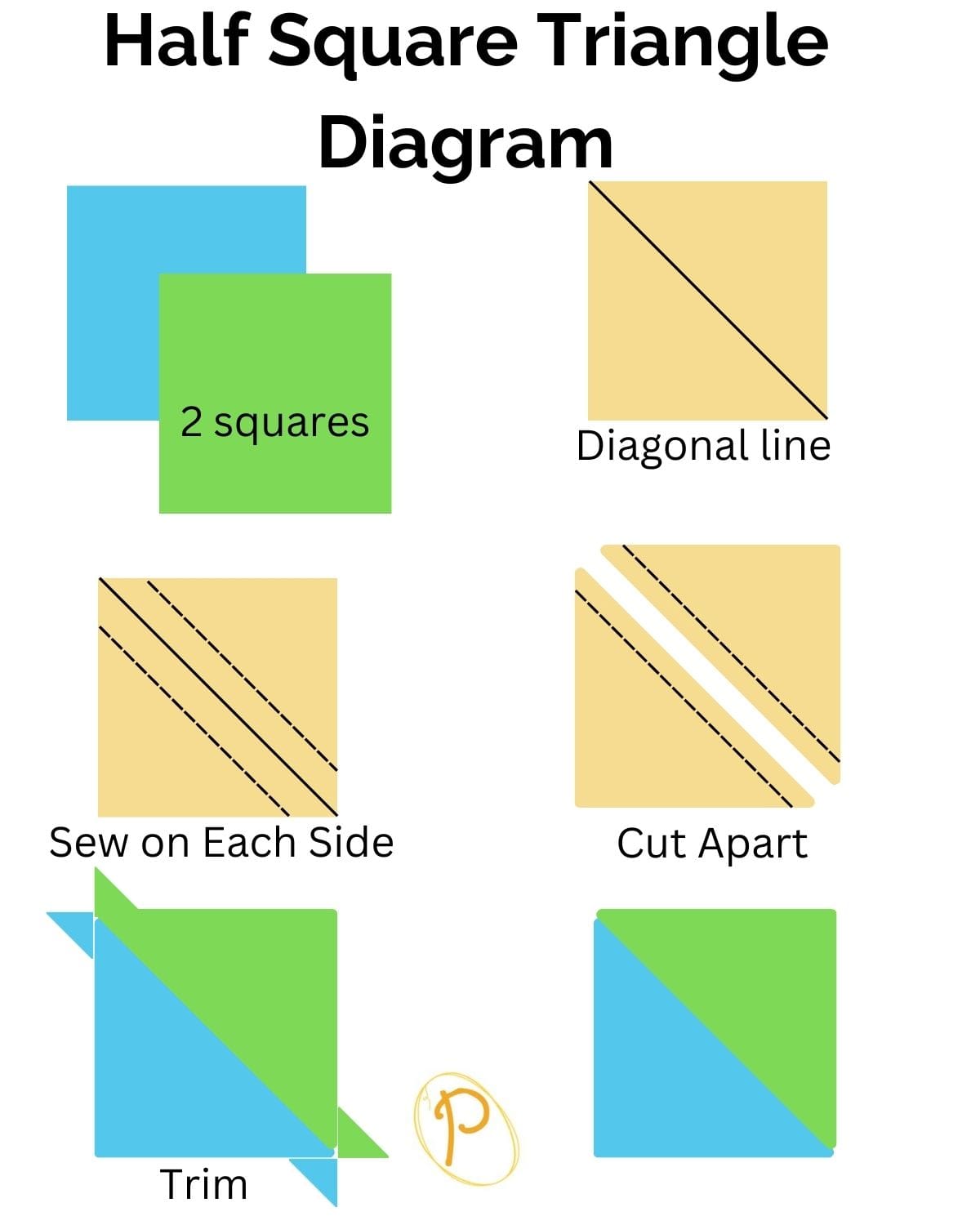
Use a fine pencil to draw a diagonal line on the wrong side of the 3 7/8” X 3 7/8” white squares.
Place a white square on top of a blue square with right sides together and sew 1/4” seam on both sides of the diagonal line. Align a ruler with the pencil line and cut the fabric apart on the drawn line to create two half square triangles.
Repeat for the other 15 – white 3 7/8” X 3 7/8” squares and 15 – blue 3 7/8” X 3 7/8” squares.
Press each half square triangle toward the darker side or press the seams open. Trim the half square triangle blocks to measure 2 1/2 X 2 1/2.
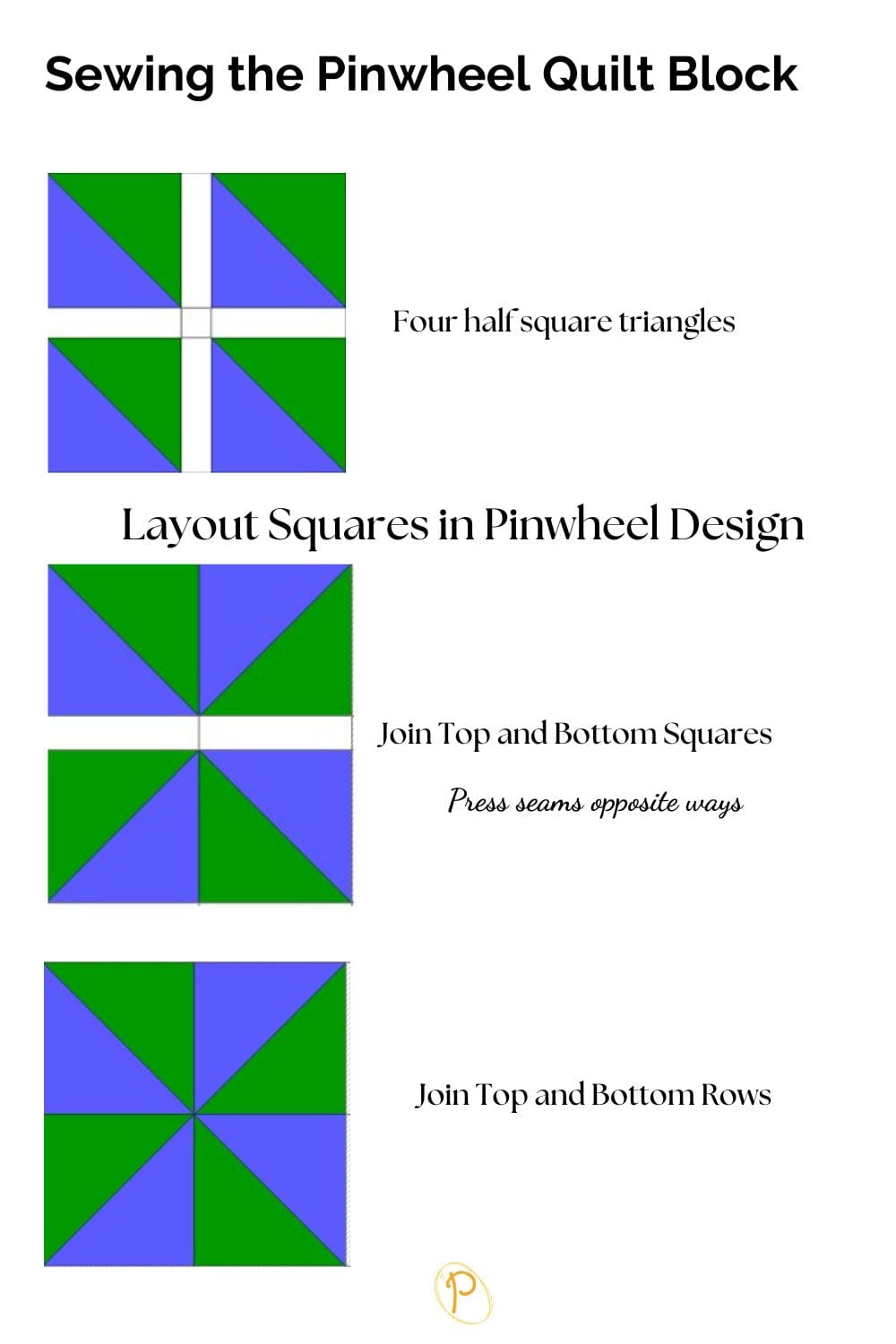
Lay out the half square triangles to form the pinwheel design.
Sew the top two blocks with the right sides together. Press seam to the right or open. Sew the bottom two blocks with the right sides together. Press seam to the left.
Sew the top and bottom row with the right sides together, making sure to line up the seams. Press the seams open.
Trim to 4 1/2″ X 4 1/2″ Square if needed. (Repeat the steps until all 8 Dark Blue and White Pinwheel Blocks are sewn).
Star Block Panels

Use the following fabric pieces:
- White Fabric Cut 8 – 3 7/8” X 3 7/8” squares.
- Yellow Fabric Cut 8 – 3 7/8” X 3 7/8” squares.
- Royal Blue Fabric Cut 8 – 2 1/2″ X 16 1/2″ rectangles.
- Red Fabric Cut 16 – 2 1/2″ X 6 1/2″ rectangles.
Sew the Panel
Use a fine pencil to draw a diagonal line on the wrong side of the 3 7/8” X 3 7/8” white squares.
Place a white square on top of a yellow square with right sides together and sew 1/4” seam on both sides of the diagonal line. Align a ruler with the pencil line and cut the fabric apart on the drawn line to create two half square triangles.
Press each half square triangle toward the yellow side or press the seam open. Trim the half square triangle blocks to measure 2 1/2 X 2 1/2.
Lay out the half square triangles with the yellow fabric next to each other to form the triangle.
Sew the two blocks with the right sides together with 1/4″ seam allowance. Press seams open.
Place a red 2 1/2″ X 6 1/2″ rectangle on each side of the yellow and white rectangle. Sew the right sides together with 1/4″ seam allowance.
Press the seams to the outside or open. Trim this strip as needed to measure 2 1/2″ X 16 1/2″.
Place a royal blue 2 1/2″ X 16 1/2″ rectangle on top of the red strip. Sew the right sides together with 1/4″ seam allowance. (See the photo to help with placement).
Press the seams to the blue fabric or open. (Repeat the steps until all 8 Star Block Panels are Sewn).
Red, Blue and Cream Star Block
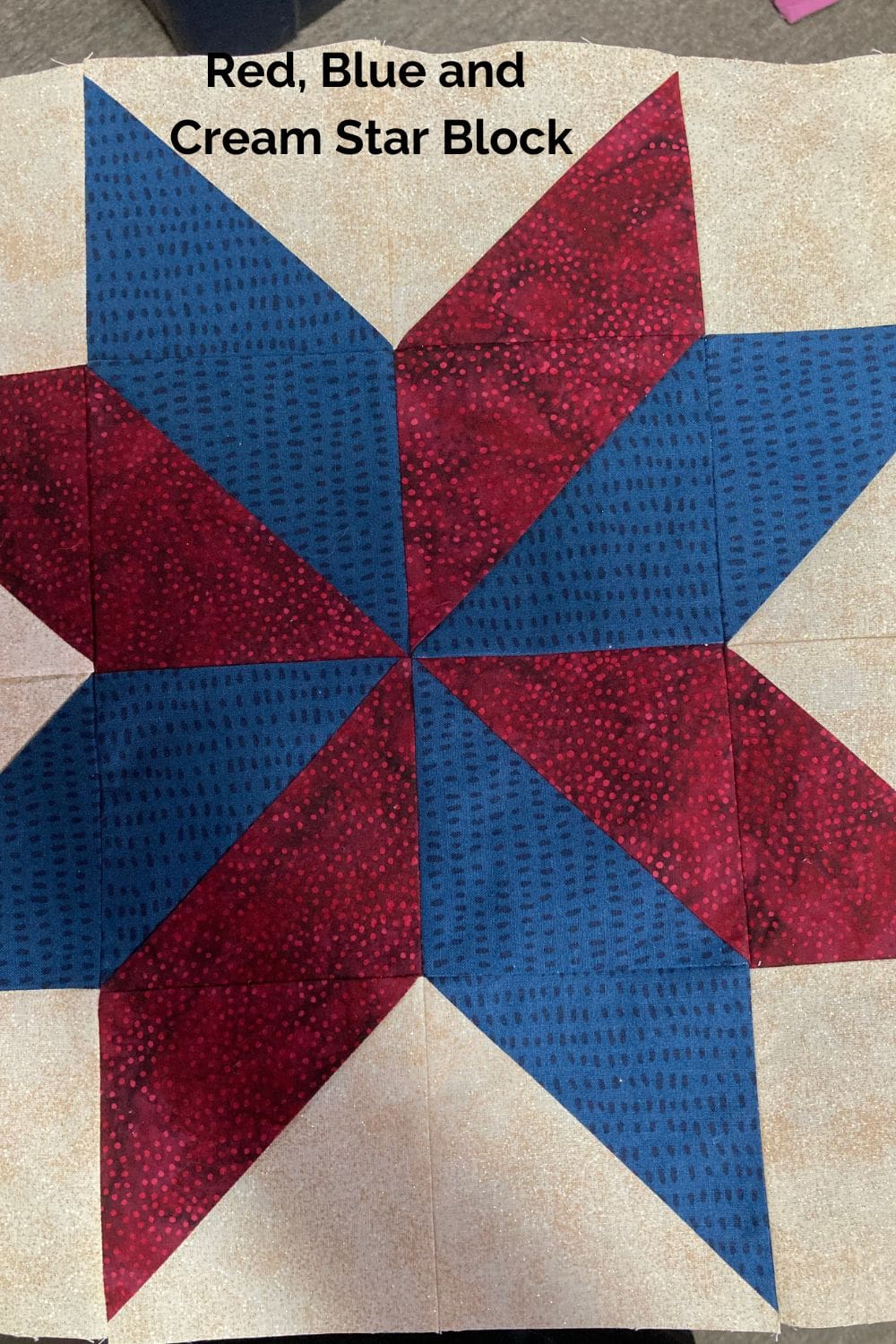
Use the following fabric pieces:
- Red Fabric Cut 8 – 5 7/8” X 5 7/8” squares.
- Dark Blue Fabric Cut 8 – 5 7/8” X 5 7/8” squares.
- Cream Fabric Cut 8 – 5 7/8” X 5 7/8” squares.
- Cream Fabric Cut 8 – 4 1/2″ X 4 1/2″ squares.
Sew the Star Block
Use a fine pencil to draw a diagonal line on the wrong side of the red 5 7/8” X 5 7/8” squares.
Place a red 5 7/8” X 5 7/8” square on top of a blue 5 7/8” X 5 7/8” square with right sides together and sew 1/4” seam on both sides of the diagonal line. Align a ruler with the pencil line and cut the fabric apart on the drawn line to create two half square triangles.
Repeat 3 more times.
Place a red 5 7/8” X 5 7/8” square on top of a cream 5 7/8” X 5 7/8” square with right sides together and sew 1/4” seam on both sides of the diagonal line. Align a ruler with the pencil line and cut the fabric apart on the drawn line to create two half square triangles.
Repeat 3 more times.
Use a fine pencil to draw a diagonal line on the wrong side of the four remaining 5 7/8” X 5 7/8” cream squares.
Place a cream 5 7/8” X 5 7/8” square on top of a blue 5 7/8” X 5 7/8” square with right sides together and sew 1/4” seam on both sides of the diagonal line. Align a ruler with the pencil line and cut the fabric apart on the drawn line to create two half square triangles.
Repeat 3 more times.
Press each half square triangle seam to the darker fabric side or open. Trim the half square triangle blocks to measure 4 1/2 X 4 ½ as needed.
Assembling and Sewing the Star Block
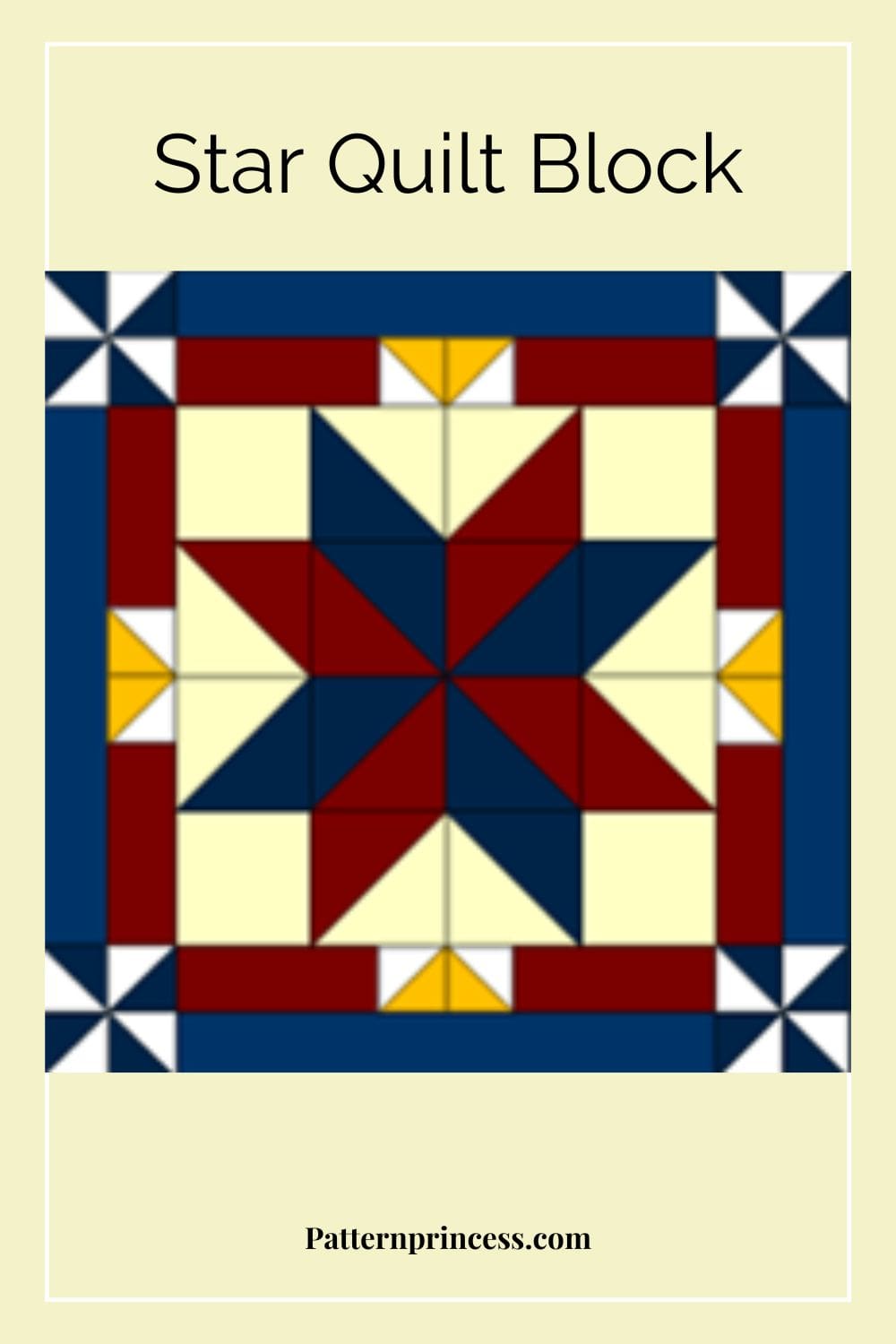
Lay out the red and blue half square triangle blocks to form the pinwheel design. (See the photo to help with placement).
Sew the top two blocks with the right sides together with 1/4″ seam allowance. Press seam to the right or open. Sew the bottom two blocks with the right sides together with 1/4″ seam allowance. Press seam to the left or open.
Place the two rows right sides together aligning the center seams. Pin in place and sew the rows together. Press the seam open.
Trim block to 4 1/2″ X 4 1/2″ if needed.
Arrange the red and cream, the blue and cream half square triangle blocks around the 4 1/2” X 4 1/2″ block.
Place a solid cream colored 4 1/2″ X 4 1/2″ block in each corner. (Refer to the photo for placement).
With right sides together, sew two of the half square triangle on the sides of the 4 1/2” X 4 1/2″ block with 1/4” seam allowance. Press seams toward the center or open.
With right sides together, sew the top middle half square triangle blocks together with a 1/4″ seam allowance. Press the seams open.
Place a 4 1/2″ X 4 1/2″ cream block on either side of the top half square triangle blocks that were just sewn together. With right sides together, sew the cream corner blocks on with a 1/4″ seam allowance. Press the seams toward the outside or open.
With right sides together, sew the bottom middle half square triangle blocks together with a 1/4″ seam allowance. Press the seams open.
Place a 4 1/2″ X 4 1/2″ cream block on either side of the bottom half square triangle blocks that were just sewn together. With right sides together, sew the cream corner blocks on with a 1/4″ seam allowance. Press the seams toward the outside or open.
Now there are three rows to sew together. With the right sides together, sew the top row onto the center row. Then sew the bottom row onto the center row. Press seams open.
Trim the block, if necessary, to measure 16 1/2″ X 16 1/2″ Square. (Repeat the steps for the second Star Block).
Block Assembly
With the right sides together, making sure to align the seams, sew a star block panel on the sides of the star block using 1/4″ seam allowance. Press the seams to the outside.
With the right sides together, sew a dark blue and white pinwheel block on the left and right of the top Star Block Panel, using 1/4″ seam allowance. Press the seams to the inside.
With the right sides together, sew the top panel to the top of the star block using 1/4″ seam allowance. Press the seam to the outside or open.
Sew a dark blue and white pinwheel block on the left and right of the bottom star block panel, using 1/4″ seam allowance. Press the seams to the inside.
With the right sides together, sew the bottom panel to the bottom of the star block using 1/4″ seam allowance. Press the seam to the outside or open.
Trim the block to measure 24 1/2″ X 24 1/2″ if needed. (Repeat the block assembly for the second Star Block).
8 1/2-inch Pinwheel Quilt Block
- Red Fabric Cut 1 – 5 7/8” X 5 7/8” square.
- Dark Blue Fabric Cut 1 – 5 7/8” X 5 7/8” square.
- Cream Fabric Cut 2 – 5 7/8” X 5 7/8” squares.
Sew the Pinwheel
Use a fine pencil to draw a diagonal line on the wrong side of the cream 5 7/8” X 5 7/8” squares.
Place a cream square on top of a dark blue 5 7/8” X 5 7/8” square with right sides together and sew 1/4” seam on both sides of the diagonal line. Align a ruler with the pencil line and cut the fabric apart on the drawn line to create two half square triangles.
Place a cream square on top of a red square with right sides together and sew 1/4” seam on both sides of the diagonal line. Align a ruler with the pencil line and cut the fabric apart on the drawn line to create two half square triangles.
Press each half square triangle toward the darker side or open. Trim the half square triangle blocks to measure 4 1/2 X 4 1/2.
Lay out the half square triangles to form the pinwheel design.
Sew the top two blocks with the right sides together. Press seam to the right or open. Sew the bottom two blocks with the right sides together. Press seam to the left or open.
Sew the top and bottom row with the right sides together, making sure to line up the seams. Press the seams open.
Trim to 8 1/2″ X 8 1/2″ Square if needed.
Pinwheel Block with Frame Block
- White Fabric Cut 4 – 3 7/8” X 3 7/8” squares.
- Red Fabric Cut 4 – 3 7/8” X 3 7/8” squares.
- Royal Blue Fabric Cut 4 – 2 1/2″ X 4 1/2″ rectangles.
- Royal Blue Fabric Cut 4 – 2 1/2″ X 8 1/2″ rectangles.
Sew the Pinwheel
Use a fine pencil to draw a diagonal line on the wrong side of the white 3 7/8” X 3 7/8” squares.
Place a white square on top of a red 3 7/8” X 3 7/8” square with right sides together and sew 1/4” seam on both sides of the diagonal line. Align a ruler with the pencil line and cut the fabric apart on the drawn line to create two half square triangles.
Repeat for the other red 3 7/8” X 3 7/8” square and white 3 7/8” X 3 7/8” square.
Press each half square triangle toward the red side or open. Trim the half square triangle blocks to measure 2 1/2 X 2 1/2.
Lay out the half square triangles to form the pinwheel design.
Sew the top two blocks with the right sides together. Press seam to the right or open. Sew the bottom two blocks with the right sides together. Press seam to the left or open.
Sew the top and bottom row with the right sides together, making sure to line up the seams. Press the seams open.
Trim to 4 1/2″ X 4 1/2″ Square if needed.
Adding Sashing Pieces to the Pinwheel Block
Place a royal blue 2 1/2″ X 4 1/2″ rectangle on the top and bottom of the pinwheel block. Sew with the right sides together using a 1/4″ seam allowance.
Press the seams to the outside or open.
Place a royal blue 2 1/2″ X 8 1/2″ rectangle on the sides of the pinwheel block. Sew with the right sides together using a 1/4″ seam allowance.
Press the seams to the outside or open.
Trim to 8 1/2″ X 8 1/2″ Square if needed.
(Repeat the steps for the second Pinwheel Block with Frame Block).
Middle Block Assembly
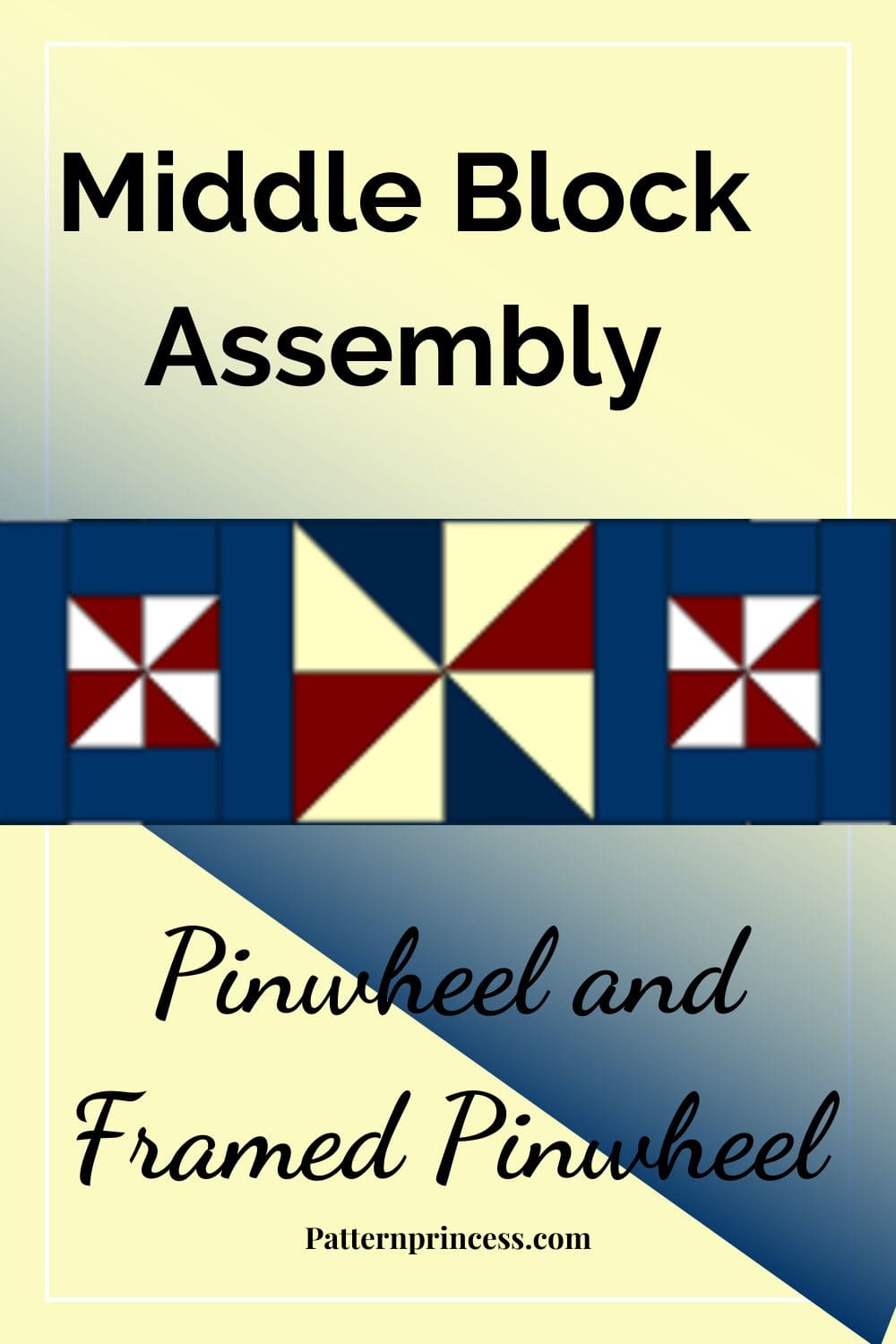
Place a pinwheel block with frame block on either side of the 8 1/2-inch pinwheel quilt block.
Place a pinwheel block with frame block on either side of the 8 1/2-inch pinwheel quilt block.
Assembling the Table Runner Top
Place a star block on the top and bottom of the pinwheel block. With right sides together, sew the top star block onto the middle pinwheel block using 1/4″ seam allowance.
Press seam to the outside or open.
With right sides together, sew the bottom star block onto the middle pinwheel block using 1/4″ seam allowance.
Press seam to the outside or open.

Table Runner Border
Dark Blue Fabric Cut 2 – border strips 1 1/2″ X 58 1/2” (or piece blue fabric together to create the strip).
Dark Blue Fabric Cut 2 – border strips 1 1/2″ X 24 1/2”
Place a 1 1/2″ X 24 1/2” border strip on the top and bottom of the table runner.
With the right sides together, sew the border strip on the top edge with 1/4″ seam allowance. Press the seam to the outside or open.
With the right sides together, sew the border strip on the bottom edge with 1/4″ seam allowance. Press the seam to the outside or open.
Place a 1 1/2″ X 58 1/2” border strip on the sides of the table runner.
With the right sides together, sew the border strip on the sides with 1/4″ seam allowance. Press the seam to the outside or open.
Prepare the Table Runner Back, Binding, and Batting
Table Runner Back. Fabric requirement is just under 2 yards of a 44” wide cotton fabric that coordinates with the colors of the quilt top. Cut a rectangle 31” X 64” of fabric for the back. This will allow for approximately 4-inches of fabric to extend all around the edges of the table runner top.
Binding. You will need 180-inches of binding. Plan on approximately 3/4 of a yard. To make your own binding. Cut 5 – 2 1/2” X 44” strips of fabric. Trim the ends of each strip at apposing 45-degree angles.
Take the binding strips and sew them together aligning the 45-degree ends. Press the seams open.
Fold the binding strip in half with the wrong sides together and press.
Batting. Use a thin cotton batting such as warm and natural. Trim the batting to measure 31” X 64”, the same size as the quilt back. This will allow the batting to also extend beyond the edges of the table runner top.
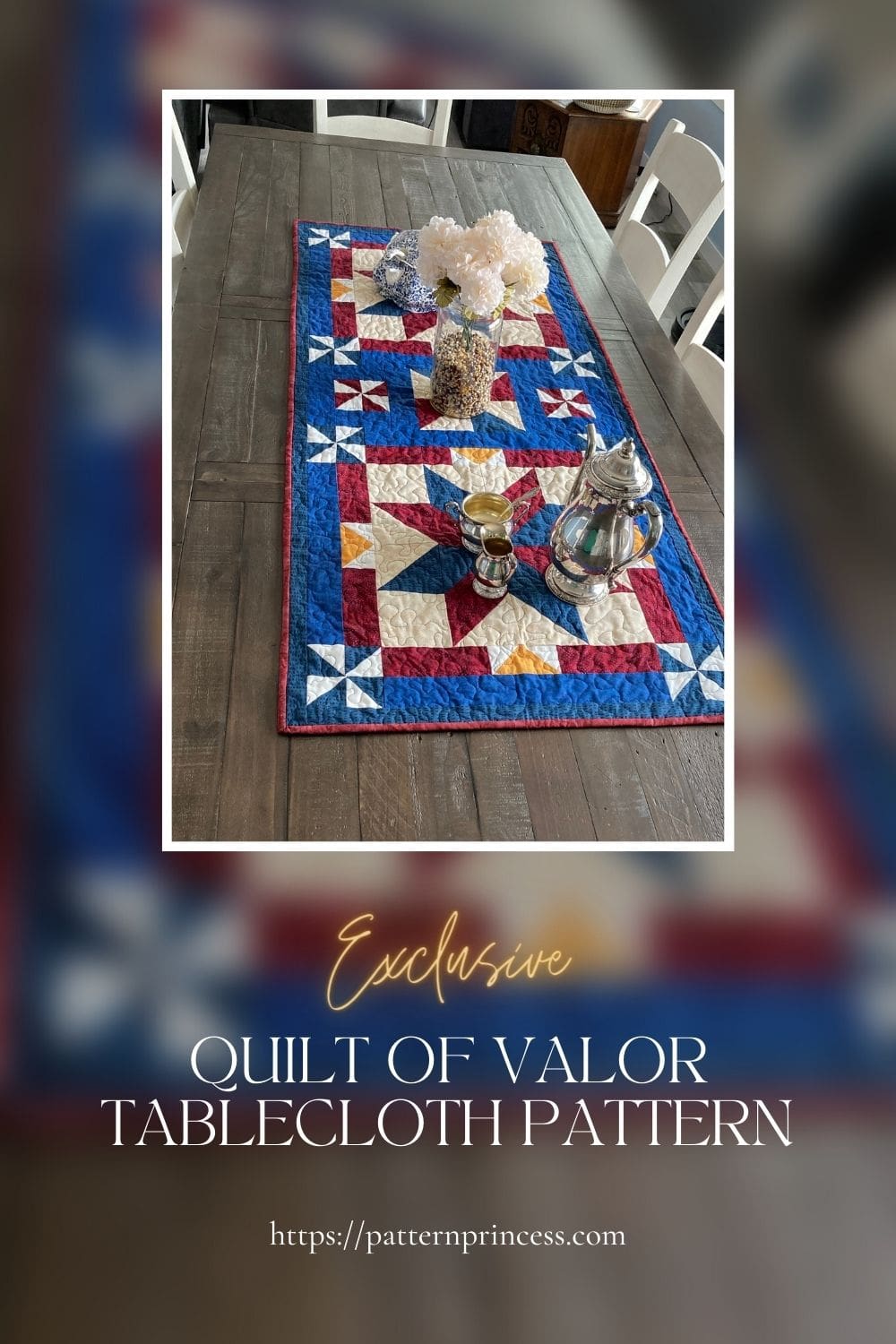
Pin the Layers Together
Now it is time to make the quilt sandwich. This is the term that is often used to describe placing the backing fabric on the bottom, the batting in the middle, and the top decorative fabric on the top.
On a large surface, place the backing fabric face down. Use masking tape or painter’s tape to tape the backing fabric down. Making sure to smooth out any wrinkles, yet not stretching the fabric.
Next lay the batting over the backing fabric. Again, smooth out any wrinkles.
Finally, place the quilt top fabric on the top with the right side up. Center the top fabric in the middle of the two bottom layers making sure that a few inches extend out beyond the quilt top on all sides.
Once all three layers are in place, make sure to smooth out any wrinkles. Use basting spray or stainless-steel safety pins to base the quilt layers together. Place one pin every 4-5 inches.
Quilting the Layers Together
While you can sew the layers together by hand, I prefer to use my sewing machine for quilting the layers together. Once you choose your design, set up your sewing machine for quilting by using a darning foot and dropping the feed dogs on the sewing machine. This will allow you to free motion quilt your design.
Binding the Quilted Table Runner
Once the layers are quilted, it is time to add the binding strip to the quilt.
Sew Binding onto the Quilt
Pin the raw edge of the binding onto the top quilt fabric edge. I generally start in the middle of a side. Leave approximately a 5” tail hanging. This hanging part will be used to sew to the other end of the binding strip when you have finished sewing all four sides of the table runner quilt.
Sew the binding onto all four sides of the table runner quilt making sure to miter the corners.
Mitering the Corners
To miter the corners, stop 1/4 inch from the corner. Use a ruler and pencil to make the location on the binding. Once you reach the 1/4 inch mark, turn your square and just sew a few stitches right off the corner. Trim your thread, not the binding strip though.
Folding the Mitered Corner
Fold the binding strip away from the direction you were just sewing at a 45° angle. Then fold the binding strip back down upon itself and match it to the edge of the square that you just sewed making sure that aligns with the raw edge of the next side that you will be sewing.
Begin stitching at the edge using the same 1/4 inch seam allowance. Repeat this process for the next 3 corners.
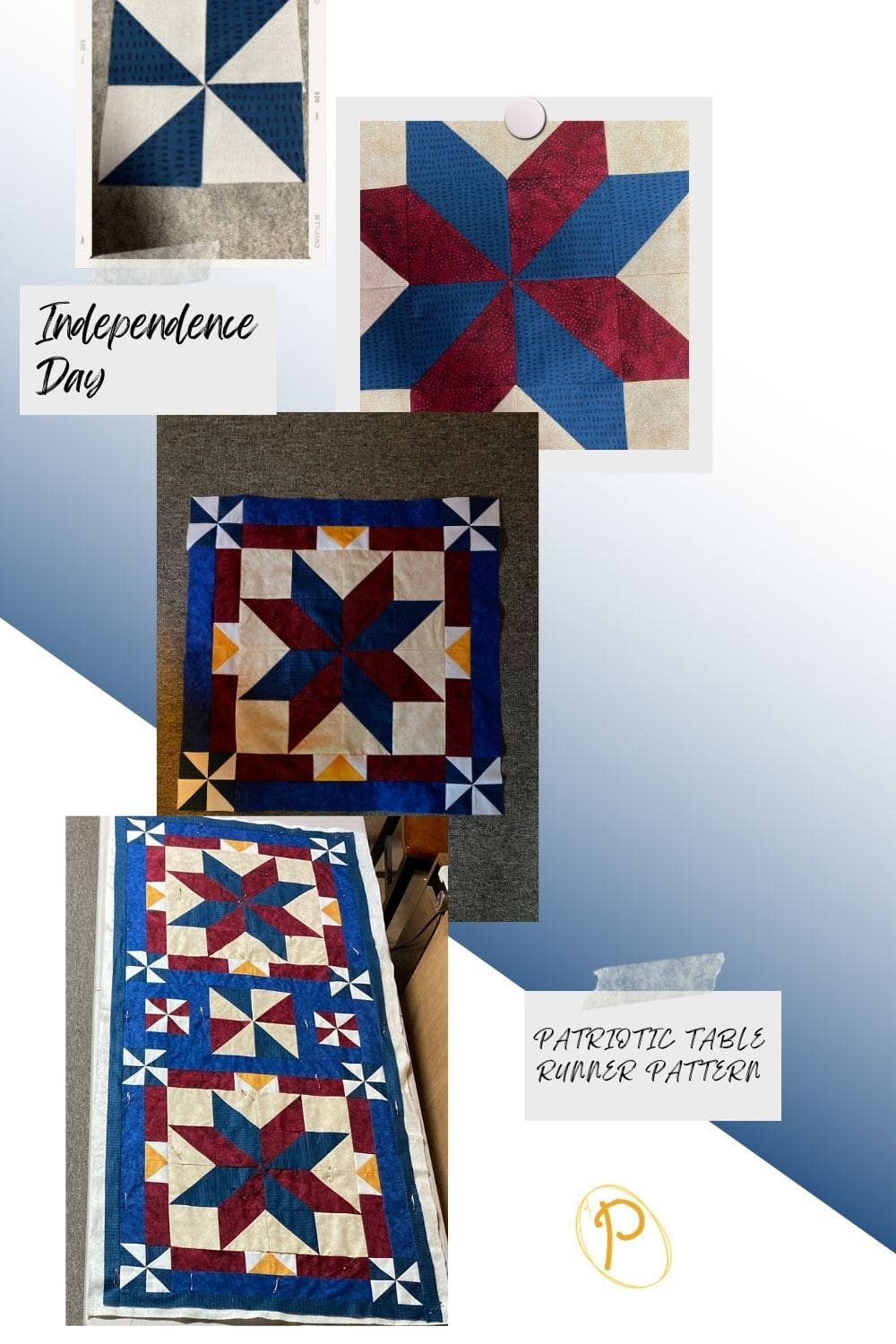
Connecting the Binding Ends
Stop stitching approximately 4” from the side where you started. Complete a few backstitches and snip the thread (but not the binding). Remove the quilt from the sewing machine so you can join the two tails of the binding.
To join the tails so there is a continuous strip of binding to finish sewing down on the quilt edge. Measure the amount of binding that is needed to finish the quilt edge, plus 1/4″. Cut a straight line on each of the binding edges the making sure to correctly measure the amount that is needed yet. With the right sides together, sew the ends together with a 1/4” seam allowance. Now you can continue to sew the binding onto the quilt.
Trimming the Batting and Backing Fabric
Trim the batting and backing fabric to 1/4″ from the edge of the quilt top. I use a ruler and rotary cutter to complete this.
Attaching the Binding to the Backing Fabric
Fold the binding over the edge and hand-stitch the folded edge of the binding strip to the backing fabric. For each corner make sure to make a mitered corner and add a few extra stitches to hold it securely.
Washing your Quilt
When washing my quilts, I like to use a few color catchers in the wash. This will help ensure that all the colors stay crisp, and nothing bleeds onto the next color. I like to dry until damp on medium heat in the dryer. Then remove and lay flat to finish drying.
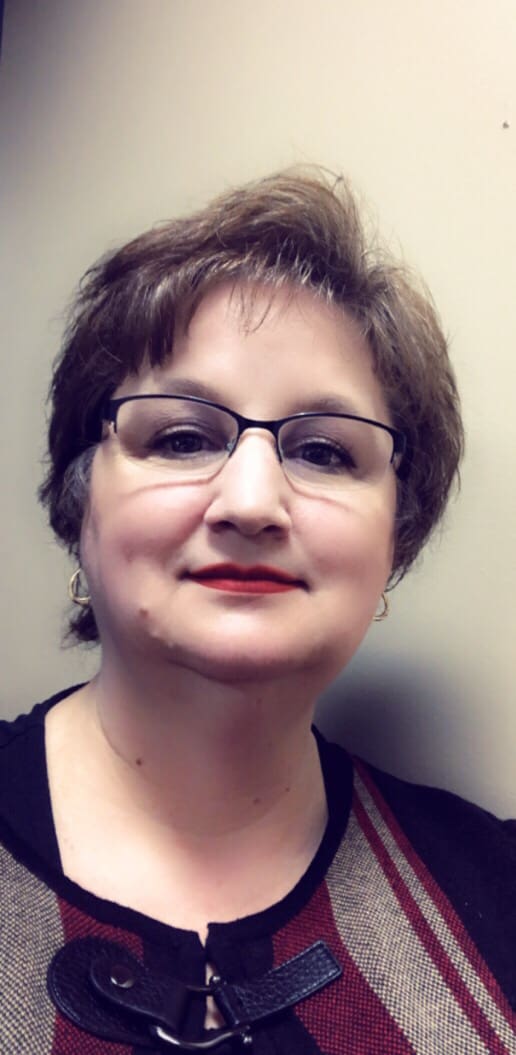
You can find Victoria crocheting, quilting, and creating recipes. She has cooked in restaurants for over 20 years, including many larger parties. She learned to crochet when she was just 11 years old and has been crocheting ever since; over 50 years now. Over 40 years ago, she loved her first class in sewing and continues to hone her skills in quilting. Many have enjoyed the handmade gifts over the years. In her professional career, she has worked in management in a wide variety of businesses including higher education as a dean of a division. All the while attending college part-time to achieve her doctorate in higher education with an emphasis in e-learning.
